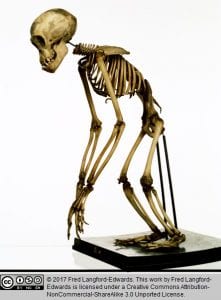The wonderful world of primate poo (and why it really matters)
By ucbtcwi, on 17 August 2017
As a biology PhD student, I’ll be the first to admit that there are some studies in science that, whilst interesting, can leave you questioning who comes up with these and why they (and we) should care so much. If you, like me, are the kind of person who loves these kinds of things, the list of past Ig Nobel prize winners is a cornucopia of great examples. Often, though, all it takes is delving a little deeper to find the importance in what seems like a pointless topic. My PhD involves collecting primate poo samples to look at their gut bacteria, and so does occasionally elicit the classic and very valid question: “But what’s the point of it?” from people, so I thought for this week’s blog post I’d try and answer exactly that.
Primates are our closest relatives and, in fact, your closest relatives are also primates, as are you yourself. We’ve known about the anatomical similarities between humans and other, non-human primates for hundreds of years. The Grant Museum of Zoology plays host to what used to be a teaching collection for doctors studying at UCL, where the bones and structures of animals from non-human primates to fish would be studied to understand how our own bodies developed from the ancestors we shared with other organisms. Then, in the 1980s, with the birth of molecular sequencing techniques, we gained the ability to study the DNA of animals. From this we began to understand just how closely related to other primates we really are, leading us to the famous fact that we are 98% genetically identical to chimpanzees, our closest relative.

A juvenile chimpanzee skeleton from the Grant Museum of Zoology, accession number Z449
The next big step, in my (admittedly, probably biased) opinion, in our understanding of the human body and how it works has been our realisation that gut bacteria are hugely important to human health and disease. We might tend to think of bacteria as harmful or infectious, but actually the bugs that live in your intestine are a normal part of a healthy human body. They outnumber our own cells 10 to 1, making us 90% bacteria in terms of cell numbers alone (although our own cells are much larger, which is why by mass we’re still mostly human), break down parts of our food that we ourselves can’t digest and even provide us with many hormones (such as 90% of our serotonin, the “happiness” hormone). In addition, gut bacteria has lately been linked to everything from keeping us lean or helping to make us obese, to maintaining normal bowel functions or exacerbating conditions such as irritable bowel syndrome.
So where do non-human primates come into this? Well, as with the Grant Museum’s collection all those years ago, it’s nothing new to study our relatives in order to understand more about ourselves. While understanding the gut bacteria of primates across the whole primate evolutionary tree lets us take a look at how gut bacteria have evolved alongside us to create a mutualistic relationship, primates in particular are a very interesting group of animals. Within the Primate Order there is huge variation in the ways that these animals live their lives, and it is by considering these differences that we can begin to understand how the variations between different human lifestyles affect our gut bacteria and so our health. For example, by comparing primates that eat mostly vegetation to species that eat fruit or meat or even gum like lorises, we can start to ask questions about how much our diet affects what bacteria can survive in the gut. Looking at animals that are highly social, such as chimpanzees or baboons, vs. those that are mostly solitary creatures such as bushbabies can tell us how gut bacteria is spread and shared between individuals, communities and even between different species living in the same area (this is not as crazy as you think – humans have been found to share skin bacteria with their pet dogs).

Primate species, diet and social structure are all thought to be important in determining an animal’s gut bacteria. Licensed under Creative Commons CC0 1.0
But it’s not just ourselves that we can learn things about when we study non-human primates. One large aspect of my PhD looks at how life in captivity affects the gut microbiomes of primates. Whilst life in captivity is not ideal for any animal, raising them in zoos and centres can have benefits for endangered species. Studying the gut bacteria has the potential to offer suggestions on how we might be able to enrich the diets of captive animals to ensure they maintain healthy gut bacteria whilst living in zoos. Furthermore, by looking at what nutrients are necessary to keep a healthy set of bacteria, we might be able to start thinking about conservations issues such as which plants are highly important to conserve alongside these endangered animals.
So, I hope I’ve convinced you that gut bacteria are important, that my area of research has the potential to be of great help, and above all, that primate poo is a great thing to study.
 Close
Close

